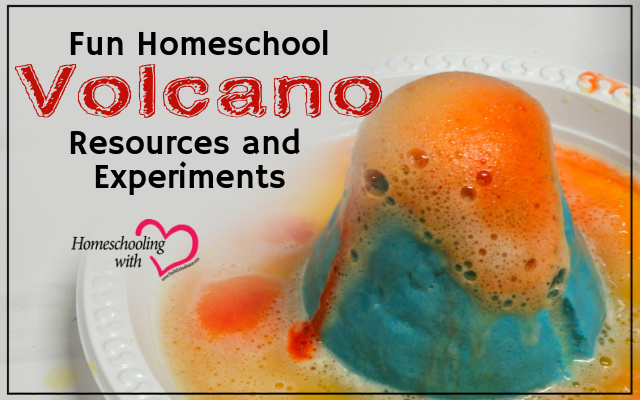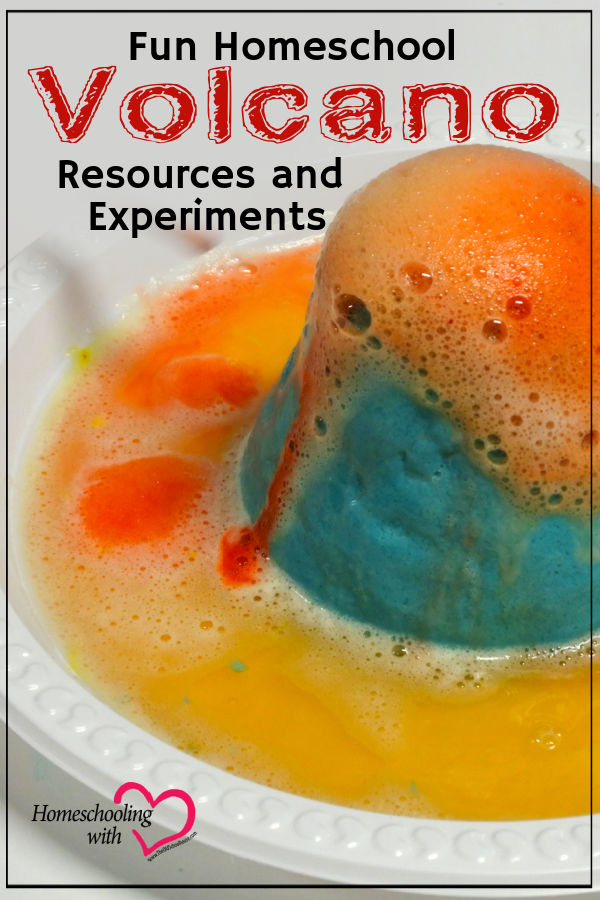Fun Homeschool Volcano Resources and Experiments


With the right homeschool volcano resources, you will be well on your way to creating a fun and memorable experience for your children! With the following fun facts and simple materials found easily around your home or at your local grocery store, you and your children will have a blast learning about volcanoes!
Volcano Facts
- Did you know that there are presently 1500 active volcanoes worldwide?
- Did you know that some famous volcanic eruptions of modern times include Mount St. Helens in 1980 and Mt. Pinatubo in 1991?
- Did you know that the biggest known volcano in our solar system is actually on Mars? Its name is Olympus Mons, and it measures 373 miles wide and 13 miles high!
- Did you know that the object with the most volcanic activity in our solar system is Io, one of Jupiter’s moons? Covered in volcanoes, its surface is constantly changing to the large amount of volcanic activity.
- Did you know that there are also volcanoes found on the ocean floor and even under icecaps? Some of these are in Iceland!
- Did you know that volcanic eruptions can send ash high into the air, over 17 miles above the earth’s surface?
- Did you know that common volcanic gases include water vapor, carbon dioxide, sulfur dioxide, hydrogen chloride, hydrogen fluoride, and hydrogen sulfide?
- Did you know that pumice is a unique volcanic rock that can float in water? It can be used as an abrasive and is sometimes used in beauty salons for removing dry skin.
Volcano Resources
Videos:
Geography Lesson: What Is a Volcano?
Earth’s Most Destructive Supervolcanoes
Five Biggest Volcanic Eruptions Caught on Camera
Disclaimer: Please note that some videos may include evolution, the mention of millions of years, or climate change. Parental screening suggested if desired.
Real-Time Data:
Get your kids involved in tracking real-time volcanic activity using USGS.gov’s alerts. Here you can subscribe to the Volcano Notification Service, stay up-to-date with their volcano monitoring data, and read observations from the Alaska Volcano Observatory.
National Geographic:
View this incredible slideshow created by National Geographic showcasing volcanoes around the world.
Geology.com:
Check out these volcano-related videos and facts provided for educational purposes.
Volcanoes and Volcanic Eruptions
Study.com:
For older students, a free lesson on volcanoes is available including videos, quizzes, and a test.
The Helpful Garden:
Use these free printable cards to use in your study of volcanoes for visual reference.
Montessori Volcano Nomenclature Cards
Volcano Experiments
Now for the fun part! Once you teach your children the basics of how to create a chemical reaction that can mimic a volcano eruption, they will be able to create their own volcano! Explain to them that when they combine vinegar and baking soda, the gas called carbon dioxide is formed. This is the same type of gas used to carbonate soda. Ask them what happens when they shake up a soda. They will most likely respond that it can explode or fizz everywhere once opened. Explain that this is because the gas is trying to spread out, but there simply isn’t enough room in the bottle so it searches for an opening. Once it finds an opening, it releases quickly, causing an eruption!
Your children can make a simple volcano using a 2-liter bottle with minimal preparation, but please note that this is an outdoor activity.
If you are looking to make the ever-so-famous papier-mâché version, check out Science Sparks. Here you can find the directions for a clay, papier-mâché, or play dough version. An easy to follow video is included. A sand volcano is another option, and you can even use snow! Simply go into your sandbox or place some sand on a cookie sheet, create a volcano shape as large as you would like, and use the same process as the papier-mâché version using baking soda, vinegar, and food coloring.
With minimal prep work, you can teach your children about volcanoes and even have them participate in hands-on activities as they learn!













































